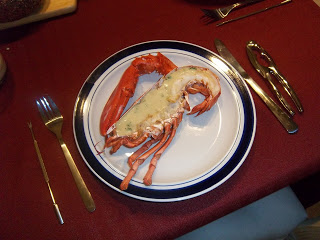This recipe is one of several taken from Elizabeth Raffauld’s 1769 classic The Experienced English Housekeeper. Back then, and right up to the early 20th Century, in more well-to-do houses, cold roast meats were served up for luncheon. The meat was left over from the previous evening’s roast. If the meats had to be kept longer, or eked out, they would be potted, i.e. made into a pâté. Follow this link to see all the potted meat & fish recipes cooked thus far (this is the tenth!).
Jane only gives an abridged version of the receipt, but here
it is in full:
Take as much lean of a
boiled
ham as you please and half the quantity of fat. Cut it as thin as
possible, beat it very fine in a mortar with a little oiled butter, beaten
mace, pepper and salt, put part of it in a china pot. Then beat the white part
of a fowl with a very little seasoning, it is to qualify the ham. Put a lay of
chicken, then one of ham, then chicken at the top, press hard down, and when it
is cold pour clarified butter over it. When you send it to the table cut out a
thin slice in the form of half a diamond and lay it round the edge of your pot.
Jane also updates the recipe: she allows us to use an electric food processor, and she uses already ground mace. She also uses clarified butter to make the pâté, not just to seal it.
She also suggests letting it sit for a few days before eating it, so that the flavours can develop.
Jane also updates the recipe: she allows us to use an electric food processor, and she uses already ground mace. She also uses clarified butter to make the pâté, not just to seal it.
She also suggests letting it sit for a few days before eating it, so that the flavours can develop.
If you’ve never potted your own meat or fish, this recipe is
a good place to start. In fact, it more of a system than a recipe, and can be
adapted easily for other meats. I’d just add that a smoked ham would work best
here – I used a smoked ham hock – and that you should over-season everything
ever-so-slightly. If you are using cold meats, add a tablespoon or two of
boiling water when blending to produce a nice smooth paste.
At Christmastime, you’re more likely to have left over
turkey than chicken and I think it would work just as well.
#434 To Pot Ham with
Chicken. Rather a subtle one this one, but no worse for it. Many of the
other recipes are quite strongly flavoured, so this is a good introduction. The
combination of salty ham and bland chicken is a good one, and it was great
spread on toast with a little medlar
jelly. As mentioned above, a great way to use up left-over meat at
Christmastime. 7/10












































